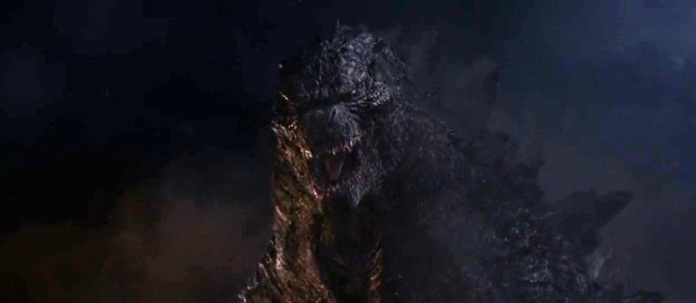
Director: Gareth Edwards
By Roderick Heath
Like many young boys, I was once a Godzilla freak. Worse, I was a perpetually frustrated Godzilla freak. For a long time, the only entry in Toho Studios’ banner series I had available to me was Godzilla 1985, the somewhat altered New World Studio recut of The Return of Godzilla (1984), at the time, Big G’s first film in 10 years. Godzilla 1985 was, however, a great place to start with the most famous of atomic monsters, because it stripped its iconic monster back to the force of nature and terror it had begun as in Ishiro Honda’s great 1954 original. That stature had been diluted and then erased through the ’60s and ’70s as Godzilla had been turned increasingly into a giant tag-team wrestler taking on motley foes in increasingly weak instalments. By the time of Godzilla vs. Megalon (1973), the lizard was delivering flying karate kicks and swapping high-fives with his robot buddy.

Toho’s revived series soon brought back the antagonists and continued until 2004, whilst in between came a film remembered by every scifi fan in fear and loathing, Roland Emmerich’s Godzilla (1998). Emmerich’s film wasn’t actually a Godzilla film, tossing out just about everything that separated him from his forebears (The Beast from 20,000 Fathoms, 1951) and progeny (The Giant Behemoth, 1956; Gorgo, 1960; every other kaiju eiga) that made him King of Monsters. Another Hollywood Godzilla movie had to make up for this betrayal. The man to try this proved to be Gareth Edwards, a filmmaker with a lone, low-budget work behind him: Monsters (2009), an inventive, intelligent if pedantic movie, turning the invasive mutant beasts that littered its North American hinterlands into broad metaphors for many a contemporary ill, including illegal immigration. Edwards’ evident skill was ripe for a richer canvas, and his Godzilla is his play for directorial megatonnage, whilst giving the vintage Toho franchise new life. The carefully hyped product has been generating excitement in everyone with the slightest glimmer of fondness for Godzilla, but it had its work cut out for it to stand out in the field of modern special-effects movie, like Cloverfield (2006) and Pacific Rim (2013), where cities are regularly levelled and colossal beasts are terrorising humankind.

Edwards, to his credit, makes all the right moves early on, kicking off with a clever opening credits sequence that moves from pages of Darwinian evolution to photos of mysterious happenings and monstrous phenomena around A-bomb test sites, real and fake grainy photos, with cast and crew names flashing on screen in swiftly redacted excerpts. Edwards gives signs early on that his playbook is inflected by Steven Spielberg as much as by Toho. What the rising crane shot to reveal a vista is to Spielberg, a peak into a vertiginous depth is Edwards, commencing with an impressive helicopter shot of a massive sinkhole in the midst of an open-cut mine teeming with antlike humans, a visually impressive and thematically keen vision of what’s to come. Scientists Dr. Ichiro Serizawa (Ken Watanabe) and Vivienne Graham (Sally Hawkins) are brought to the mine in the Philippines to behold an amazing discovery in the sinkhole—the bones of a colossal saurian skeleton with two strange pods in its chest cavity, one of which seems to have hatched recently and disgorged something large. Meanwhile, in Japan, nuclear safety watchdog Joe Brody (Bryan Cranston) and his wife Sandra (Juliet Binoche) are alarmed by strange seismic and electrical disturbances at the nuclear power plant where they work. Just as Joe begins shutting the plant down, something bursts into the sub-basement where Sandra and an inspection team are working, and releases a flood of radioactive smoke. Edwards wrings the climax of this sequence for high emotion, as Joe is forced to seal off a corridor, leaving Sandra and the other workers trapped, with Joe saying farewell to his wife through a pane of Perspex before she is sealed away forever.
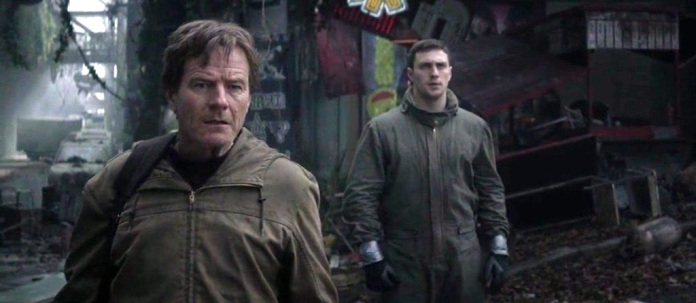
The film jumps 15 years to find Joe, now a damaged, hysterical seeker of the truth, venturing into the quarantined zone around the destroyed reactor in search of old data. His and Sandra’s son, Ford (Aaron Taylor-Johnson), is a bomb disposal expert just returned from active duty and reunited with his doctor wife Elle (Elizabeth Olsen), and has long since written his old man off as a crackpot. Nonetheless, he ventures to Japan to bail him out, only to be promptly dragged back into the quarantine zone with him as Joe urgently tries to convince him of strange phenomena that portend another cataclysmic event, an event presaged by the mysterious absence of any radiation in the hot zone. Joe and Ford are captured by guarding soldiers and brought to Serizawa and Graham, who are keeping watch on a mysterious something buried in the ruins, the weird, crusty subterranean beast that caused the initial disaster and has now been growing fat and strong from absorbing all of the fallout. Of course, Joe and Ford’s arrival coincides just about exactly with the creature waking up and bursting out of its cocoon to wreak havoc. If you’re expecting this to be Godzilla, though, you’d be wrong, because this is rather a colossal, insectoid monster dubbed Muto—“Massive Unknown Terrestrial Organism”—that pulverises everything in sight and spreads its wings to fly into the night.
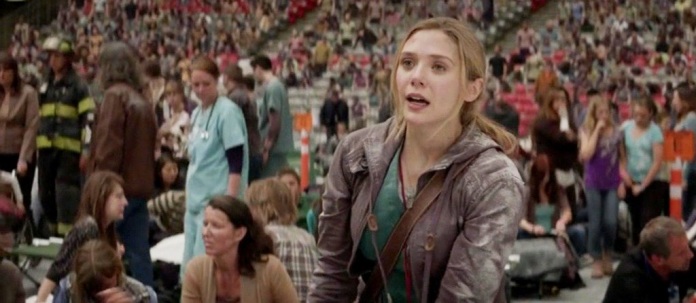
I was bemused by some early reviews that criticising the film for taking too long to get to the monster stuff, because most of the time, critics (justifiably) bawl out modern genre films for being too quick at cutting to the chase. Edwards and screenwriter Max Bornstein spend a lot of time setting up a rigorously old-fashioned approach to their storytelling. There’s some nice humour and character moulding early on, like a great little scene in a Japanese police station where Ford waits for his father to be released, entertained by watching as a Goth girl is collected by chastising parents before catching sight of his old man, who looks out with a detectable mix of shame and gratitude to his son. Whereas even the ardent Pacific Rim skipped most of that stuff to revel in the fantastic world it created, this Godzilla goes for an old-school tempo of ominous suggestion, startling glimpse, and finally, grand reveal, in the same fashion as such great monster movies as Them! (1954) and Jaws (1975), as well as the original Honda film. The opening offers wrenching, mythic loss to invest Joe with pathos well suited to a hero in this kind of film, whilst providing a father-son redemption as its key human story pivot, pitching Joe as kin to Close Encounters of the Third Kind’s (1977) Roy Neary as a man driven to frayed extremes by tragedy and intimations of the new and terrifying, with a touch of Unabomber nuttiness to him, counterbalanced by his son’s tepid all-American rectitude (notwithstanding his being played by a British actor). Cranston, still riding the crest of a huge following from the TV series “Breaking Bad,” knows how to do edgy and irrational without losing gravitas and empathy, and his presence in the film feels at first like the film’s most inspired, galvanising choice. Unfortunately, Godzilla then does something rather stupid from which it never truly recovers: it kills Joe in a skywalk collapse during Muto’s hatching, leaving Ford to fill in as hero.

Losing its most (only, in fact) detailed and engaged protagonist, the rest of Godzilla feels unmoored in a subtle, but dogged fashion. Taylor-Johnson, a good actor who can play oddball heroes effectively (Nowhere Boy, 2010; Kick-Ass, 2011; Savages, 2012), is reduced to a veritable GI Joe figurine. The limits of Edwards’ Spielbergian mimicry, which extends to naming its main hero after one Spielberg hero and the actor who played another, becomes obvious if one were to compare the scenes of Roy Neary’s home life with those of Ford Brody’s, which are far less detailed, realistic, and vibrant. Ford and Elle never cease looking and acting like placeholders where finished characters might later be inserted, and Edwards cross-cuts in ungainly fashion between the pair in their disparate places as the action heats up, with Elle trying to stick out her healing job in the midst of calamity, but this and the final reunion of the family played for uplift remain weightless.

One motif, amongst many, the monster film shares in common with the disaster film is the need to find convincing ways to have core protagonists somehow manage to be in different places so as to witness the main points of action, but Bornstein’s script manages some awfully contrived methods to keep Ford in play. These include shoving him into the midst of havoc on Hawaii and then having him talk his way onto a squad wiring up and then dismantling a thermonuclear device in northern California. Moreover, the rest of Edwards’ excellent cast is generally left holding the bag. Watanabe is on hand to maintain the film’s Japanese connection, but spends most of the film looking vaguely stupefied, as if someone just slapped him with a fish. Hawkins has quite literally nothing to do except look gawky and worried. Notably, although the filmmakers have named Watanabe’s character after Akihiko Hirata’s troubled genius in Honda’s film, who embodied the position of the nuclear inventor dogged by guilt in creating a terrible weapon, Watanabe’s character has no real function other than to act as sagacious pronouncer (e.g. “Let them fight!” and “Nature will find a balance!”).
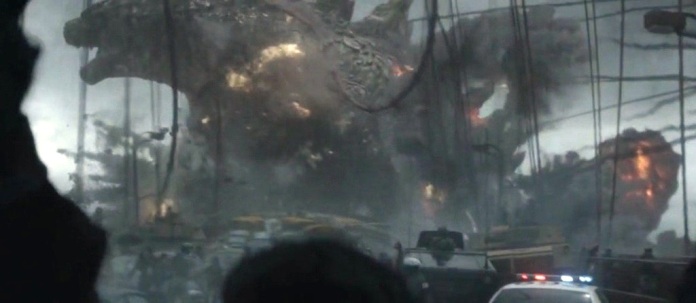
Rather than the firm antimilitarism of the early Godzilla films and their preference for scientists, journalists, and everymen as protagonists, this one makes sure to give us a resolute soldier hero straight from a recruiting poster, even if he is one who specialises in dismantling bombs rather than launching them. The film’s awkward subplot about crusty Admiral Stenz (David Strathairn) trying to lure Godzilla and foes to an H-bomb to kill them provokes perhaps the film’s most affecting genuflection to the original, emblematic meaning of all this, as Serizawa questions his decision by handing him his grandfather’s watch, which stopped forever at the time of Little Boy’s drop on Hiroshima. It’s a nicely understated moment that lets both characters and film understand the totem as sufficient unto itself. But the film is really nice to Stenz and his reasoning and cops out of any serious contemplation of the place for nuclear deterrent in the 21st century. Nor even are Godzilla and Muto actually designated as creations of the Atomic Age; rather, they are explained as prehistoric life forms that evolved when the Earth was much more radioactive to live off that energy, and merely revived by a new energy source. This fuzzy take on the key motif behind the series could have been mitigated by a clear new take on the monsters as symbolic phenomena, but nothing really sticks—certainly nothing likely to stick in the mind of any eight-year-old with as much meaning as the chillingly apocalyptic moment in Godzilla 1985 when an atmospheric nuclear blast creates a miniature nuclear winter that revives a felled Godzilla.
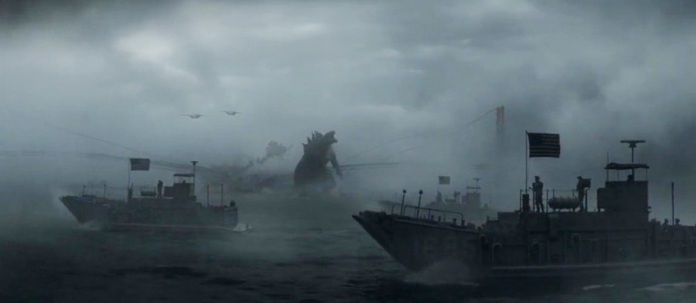
Of course, asking for highly reasoned parables and good human drama from a colossal-budget Hollywood creature feature has its churlish side. Edwards has clearly put a lot of thought and effort to one essential aspect of his film—to return to his monsters the awe and mystique engendered by truly titanic scale and impact. Muto’s hatching is grand spectacle, whilst Godzilla’s first real appearance is left until halfway through the film, savouring every hint, sign, tremor and partial glimpse. His coming is marked by cataclysm that sublimates imagery from the 2004 tsunamis as he comes ashore on Hawaii, until suddenly the whole grand beast is revealed in classic fashion in an upward camera pan that tracks the monster’s body from toenail to brow, before Big G releases his trademark concussive roar. Even better is a later sequence in which soldiers speed to Yucca Mountain, where the second, still-filled Muto egg Serizawa and Graham recovered is now stored, with Serizawa having realised the first Muto is heading to reunite with its female sibling. Soldiers begin inspecting the installation, only to find the entire backside of the mountain has been ripped out by the newly hatched and even more colossal mate, now casually ambling toward Las Vegas like a grumpy, loping teen after its first morning coffee. DP Seamus McGarvey’s images are all smoky, foggy, artfully ragged: Godzilla’s landfall at the Golden Gate Bridge—that perpetually unlucky structure!—creates at least one truly beautiful image, of the monstrous antihero striding away from the shattered bridge in a rainy morning mist. Another visually striking, if logically dumb scene has Ford and other soldiers inspect a rail bridge to see if their transport can cross it, only to realise a Muto is lurking in the shadows of the gorge it crosses, at once impersonal and blank in its scale and terribly immediate and minutely watchful in its predatory awareness.
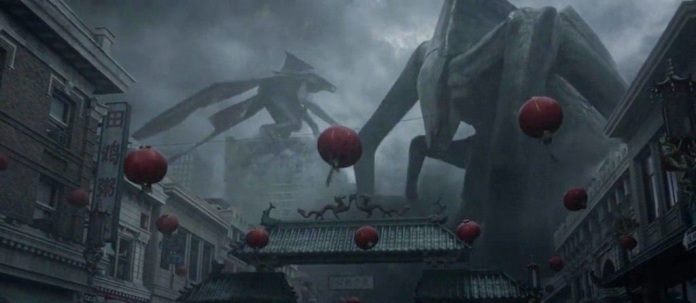
Edwards employs his monsters with sparing rigour, perhaps trying to not oversate the audience as he builds a series of crescendos and diminuendos, bringing his visions of the monsters to the edge of declarative view, but then often dodging or averting his gaze. Sustaining this quality, too, seems to have been paramount in the minds of Edwards and his FX team, as they play with how the audience sees the beasts, from the distant, abstracting authenticity of cable news broadcasts to the swooping, fearsome perspective of parachutists falling in between the squirming bodies and snapping jaws of the monsters. Edwards is so determined to lend intangible, almost religious wonder to Godzilla that he explicitly likens it to the black monolith in 2001: A Space Odyssey (1968) by playing György Ligeti’s “Requiem” during the parachuting sequence, a sequence that is the film’s most strikingly staged but also one that arrives about half an hour later than it should – -we’re already deep into the film’s climax by this point. Frankly, this evasive approach is impressive the first half-dozen times or so, but after a while, it starts to get irritating, reminiscent of the frustrating distance the first Transformers (2007) had from its nominal protagonists, as if the filmmakers had failed to really think through how to use their special effects in a dramatic way, a failing never committed by Willis O’Brien or Ray Harryhausen. This leads me to the singular thought I had in contemplating this Godzilla: it’s a monster movie for people who don’t like monster movies.
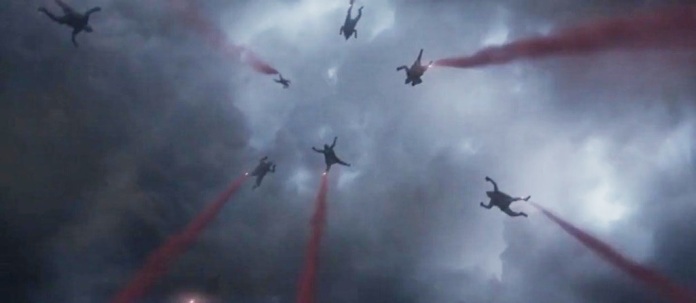
That might seem a strange comment for a film as devoted to the spectacle of giant lizards and bugs scrapping in downtown San Francisco as this one, but it stuck with me because the overall film is so pensive, so evasive in its approach to its raison d’etre. Pacific Rim, a film that stands heads and shoulders over this one for me in most respects, succeeded in providing thunderous effects and cleverly meshing them with its human drama, though admittedly it was easier there because the fate and will of the human characters was tied to their robot simulacra, which were directly engaged in action with their foes. And it was also beautiful to look at, resplendent in its hallucinatory colours, in a mobile manner sharply different to this film’s oblique aestheticism, which threatens at many points to become ponderous, especially with Edwards’ stop-start approach to action. Edwards has a great eye for big compositions and for depicting mass drama, like an awesome high shot of a highway clogged with cars and a downed airliner lying smouldering amidst the vehicles, suggesting the meeting place of Godard’s Week-End (1967) and the monster movie. Yet, like a lot of contemporary filmmakers who turn their hand to this sort of thing, the type of simple, shot-for-shot visual exposition required to gain more intimate entry into chaos and stage dynamic interpersonal action is lacking, like a late, awkwardly rushed scene in which Ford tries to incinerate the Mutos’ eggs. When the Mutos first converge on San Francisco, Edwards offers stunning shots of the duo clambering over the tops of skyscrapers, culminating in a charmingly odd moment where the two seem to kiss and one gives the other a meal—a nuclear weapon. But several minutes later, it shows dimwit office workers still caught by surprise as the monsters careen into their building.

On the other hand, Edwards knows how to sharpen his effects to a point for some powerful, climactic moments, as in the finale’s cunningly delayed introduction for his most salient gift, his ability to spit plumes of blue radioactive flame, in a manner carefully contrived to reduce every fan to tears of joy. Edwards and company visualise this as a literal build-up, the spines on Big G’s tail starting to glow, and then the glow rushing forward in a long arc on its back, disappearing into murk and then back again, before it opens its mouth and lets loose. It’s a great fillip of fan service not just because the effects are good, but because it’s staged with relish and visual acuity. And whilst Edwards seems weirdly shy of letting the Godzilla-Muto death match take centre stage, when it does, it’s satisfying, as Big G lets loose with every limb, including its tail, to wallop its enemies, whilst the two Mutos come close to taking him down when they double-team it. One shot of a wounded Godzilla, collapsed in pain and exhaustion, with Ford barely metres away from its colossal snout, captures the disparity between two life forms and also their weird accord as dusty, battered, battle-hardened warriors. There’s a flash here of peculiar poetry, the kind that gives this Godzilla some of the stature it craves. Of course, by the end of the film, Godzilla itself arises with perverse heroic stature, a living embodiment of a channelled, but not tamed power fantasy, even as it stomps out of shattered ruins and disappears back into the ocean, still primal and strange in its individual might, as a TV news title declares it “The King of Monsters.” Yes it is, even when its films are only princelings. It’s still a good night at the movies.

There are a lot of things to love about the film: The destruction of the nuclear power plant near the beginning (Juliette Binoche is quite good there), the hatching of the first Muto (it took me a while to realize this monster would not turn into Godzilla), the way it takes time to really introduce the monsters, the way Godzilla wins his battles. I wish Edwards had found a way to let Olsen and Hawkins develop into characters. Hawkins and Watanabe have the potential to be interesting.
Edwards is obviously a talented director. I’ll have to check out “Monsters” and his future films. He beats the hell out of Emmerich and Bay.
LikeLike
Hi Syd. Yes, there are some thing to love about this film (including, as you say, his dispatches of his enemies, particularly that second one), but also as you say, the supporting cast, particularly the women, are left stranded. And, yes, Binoche’s contribution is worth it even though so brief.
LikeLike
“If you’re expecting this to be Godzilla, though, you’d be wrong, because this is rather a colossal, insectoid monster dubbed Muto—“Massive Unknown Terrestrial Organism”—that pulverises everything in sight and spreads its wings to fly into the night.”
Interesting. I have not yet seen this film, but the entire gang did watch a matinee this past Sunday afternoon at a local multiplex. As per normal routine I asked each (including Lucille) to tell me what letter grade they would apply to it, and surprisingly enough the composite was a solid B, with 12 year-old Jeremy going with an A. Now with your own wind-up declaration “Its still a good night at the movies” I am most intrigued, even if the more trenchant examination would need a viewing to fully appreciate. I am a GODZILLA fan from way back, and have always held Hondo’s original in high esteem. Perhaps this is why I particularly found your opening where you confess you were also a Godzilla freak reassuring. Hope to see this soon.
LikeLike
I look forward to your own response, Sam.
LikeLike
I agree with you on all fronts here, Rod. As a thinking adult, I’m left wanting. That Marion Crane switcheroo midway through, leaving us with the leaden Ford to follow, pitching his mannequin performance all the way to the front row, diminished the experience from potentially great to only kinda fun. You’re absolutely right, the human dimension was lopped off with the death of Joe, as well as any palpable connection between the rampaging beasts and the family elements. That said, two things: 1) the single moment with the Mutos “kissing” provided some unexpected pathos, much in the same manner Edwards infuses “Monsters” with a “these are just animals doing what animals do” dimension. 2) The fighting scenes themselves were so lovingly crafted (albeit, as you’ve said, often weirdly truncated) that the kid in me smiled ear to ear. That fire breathing shot made the movie. And I suppose one could say that the only real way we could ever believe these characters would look on Godzilla at the end as a vanquishing hero and not something to be annihilated also, is for the characters to be cardboard thin. I’m guessing Joe, had he lived to see the defeat of the Mutos, would have felt otherwise.
LikeLike
I’m as glad as ever we’ve seen eye to eye on this, Rob, and I agree with your cited points of enthusiasm: the Muto kiss was inspired. I suppose other way the filmmakers could’ve sold the hero angle for Godzilla was to have made him more anthropomorphic, but then would’ve been getting close to high-fiving Godzilla again. Also, I like your “Marion Crane” crack.
LikeLike
Great review, but Takashi Shimura is not Akihiko Hirata.
Also, Joe Brody had to die because he becomes Godzilla. Well, maybe not literally, but the BIg G does take on the mantle of protective father, saving Ford’s life and destroying the beast that killed Joe’s wife.
As Freud said (almost): “A personal God[zilla] is nothing more than an exalted father-figure.”
http://cinefantastiqueonline.com/2014/06/godzilla-or-joe-brody-is-godzilla
LikeLike
Oh, shit, yes, Shimura played the elder scientist. Thanks for spotting that.
Other than that…yeah, sure, I thought that angle was pretty well self-evident, but the fact is we’re still lumped with a boring replacement hero, and it’s not good drama, Steve.
LikeLike